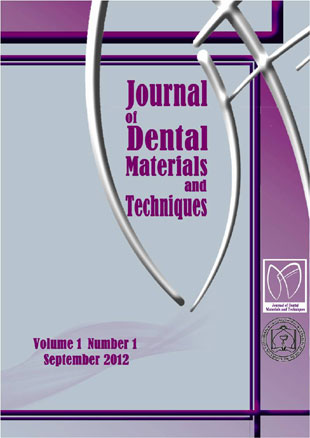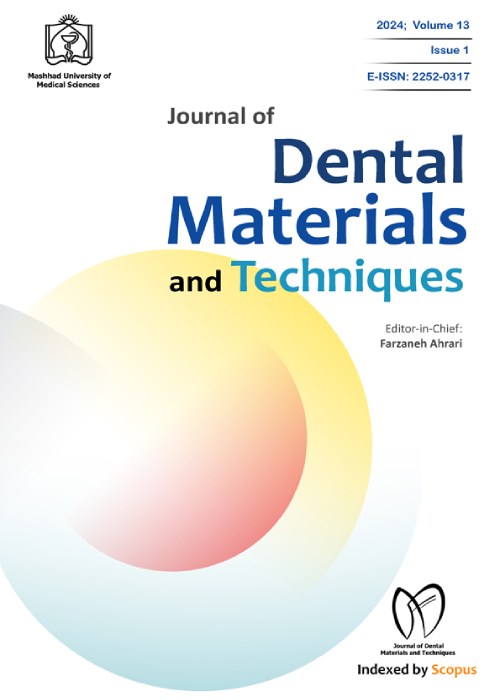فهرست مطالب

Journal of Dental Materials and Techniques
Volume:1 Issue: 1, Winter 2012
- تاریخ انتشار: 1390/10/11
- تعداد عناوین: 7
-
-
Page 1Taking into account the factors related to lip-tooth relationships in orthodontic diagnosis and treatment planning is of prime importance. Manual quantitative analysis of facial parameters on photographs during smile and speech is a difficult and time-consuming job. Since there is no comprehensive and user-friendly software package, we developed a software program called "Smile Analyzer" in the Department of Orthodontics of Mashhad Faculty of Dentistry for measuring the parameters related to lip-tooth relationships and other facial landmarks on the photographs taken during various facial expressions. The software was designed using visual basic. NET and the ADO. NET was used for developing its Microsoft Access database. The program runs on Microsoft Windows. It is capable of analyzing many parameters or variables in many patient's photographs, although 19 more common variables are previously defined as a default list of variables. When all variables are measured or calculated, a report can be generated and saved in either PDF or MS Excel format. Data are readily transferable to statistical software like SPSS for Windows.Keywords: Smile, smile analyzer, software, speech
-
Page 6IntroductionSurface roughness can increase the retention of castings by ridges and grooves that are microretentive. This study compared the retention of implant-supported crowns when used with 3 different surface roughness abutments and one temporary cement.MethodsThirty solid abutments (ITI), 4 mm high, were divided into three groups randomly. In the first group, 10 abutments were roughened with sandblast (50-µm aluminum oxide) and in the second group, 10 abutments were roughened with diamond bur. The third group had no surface treatment. Then, thirty implant fixture analogs (ITI) were placed in the center of acrylic cylinders. After that a solid abutment was tightened on the each fixture analog with 35 N/cm force. Thirty base metal crowns were made on the 4 mm ITI abutment analogs using plastic coping. The prepared copings were cemented on the abutments by TempBond temporary cement and finally, crowns were pulled from the abutment in a universal test machine at a cross speed of 0.5cm/min.ResultsThe mean tensile strength in sandblasted, bur treated, and control group were 64.38±8, 91.37±7.19, and 58.61±1.93, respectively. Bur treated group showed higher tensile strength in comparison with two other groups.ConclusionSurface modification of implant abutment by diamond bur may be an effective method to increase retention of crown when TempBond is used.
-
Page 11In restorative dentistry, selecting the proper material is an important factor for clinical success. The objective of this study was clinical evaluation of survival time of three tooth color materials in primary anterior teeth.MethodsIn this interventional clinical trial study, 94 deciduous anterior teeth (36 teeth in boys, 58 teeth in girls) belonging to 3-5 year old children in Pediatric Department of Mashhad Faculty of Dentistry, Iran were selected. Selective dental materials included compoglass, glass-ionomer Fuji II LC, and composite resin. The data were analyzed with Kaplan–Meyer and Log rank test.Resultscompoglass had the highest survival time in comparison with composite and glass-ionomer. Nine months retention rate for teeth restored with compoglass, composite resin and glass-ionomer were estimated: 95%, 21%, and 12.5%, respectively.ConclusionCompoglass can be a suitable material for anterior primary teeth restoration.Keywords: Dental restoration, primary teeth, survival time
-
Comparative Assessment of Nuclear and Nucleolar Cytochemical Parameters of Oral Epithelial Cells in Smokers and Non-Smokers by Methyl Green-Pyronin StainingPage 19A strong relationship exists between cigarette smoking and the development of oral squamous cell carcinoma. Smoking can significantly increase cellular proliferation. Nevertheless, there is little reference in literature to the cytological assessment of oral mucosa in this respect.MethodsChanges in nuclear and neucleolar cytomorphometric parameters such as diameter, surface, number and color intensity, in cytologic smears which were collected from normal buccal mucosa of 30 cigarette smokers and 30 non smokers, using methyl green-pyronin staining were studied.Our findings attested to smoking as significant inductive factor in cytochemistry as well as morphologic changes. This technique is a valuable tool.Keywords: Cytochemistry, methyl green, pyronine, nucleolus, oral mucosa, smoking
-
Page 24Angle and internal position of lateral pterygoid muscle leads to contraction over two half of the mandible in maximum opening and protrusion position so it can affects impression prosthetic procedures. The aim of this study was to evaluate the mandibular flexure in two transverse and antro-posterior dimensions.MethodsSeventy edentulous patients at Mashhad Faculty of Dentistry as the main group and 50 dentulous patients as the control group were selected. In these patients, transverse dimensions between second molar areas and also canine eminence from one side to another side, and longitudinal dimensions based on the distance between canine to second molar area at centric occlusion and maximum mouth opening were measured. Dimensional differences as the mandibular flexure were measured. The mandibular dimensions in maximum opening and closed mouth were different. Average reduction in transverse dimension on second molar region at maximum mouth opening and closing position were almost equal to -0.0787 mm for target group and 0.7512 mm for control group. On anterior side, averages of these changes were equal to 0.3069 mm for target group and were 0.2254 mm for control group. Transverse dimensions in anterior region at maximum opening position are smaller than the same dimension at closed mouth in edentulous and dentulous patients.Keywords: Centric occlusion, edentulous patient, mandibular flexure, maximum opening
-
Page 29The aim of this study was to evaluate the effect of proximal contour of class II composite restorations placed with straight or contoured matrix band using composite resins with different modulus of elasticity on stress distribution by finite element method. In order to evaluate the stress distribution of class II composite restorations using finite element method, upper right first molar and second premolar were modeled. Proximal boxes were designed and restored with universal Z250 and packable P60 composite resins (3M ESPE) using two matrix systems: flat Tofflemire matrix and precurved sectional matrix. Finally models were evaluated under loads of 200 and 400 Newton at 90 degrees angle and the results were graphically illustrated in the form of Von Misses stresses.ResultsIn general the stress obtained under 400 Newton load was significantly greater than the stress of models under 200 Newton load. Von Misses stress distribution pattern of two different Z250 and P60 composites were very similar in all modes of loading and proximal contour. In all analyzed models there was a significant difference between models restored with Tofflemire matrix with flat contour and models restored with sectional matrix with curved contour. This difference was greater in first molar than second premolar. Use of a contoured matrix band results in less stress in class II composite resin restorations.Keywords: Class II, finite element analysis, matrix band, posterior composite, proximal contour
-
Page 35The calcifying odontogenic cyst (COC) is a rare odontogenic cyst. Only 2% of all odontogenic cysts and tumors are COC. COC associated with odontoma (COCaO) reported in 24% of COCs. COCaO presents a greater incidence in female, with a ratio of 2 to 1. The highest incidence of COCaO occurs during the second decade with a mean age of 16 years, most frequently occurring in the maxilla (61.5%). Here, we describe a classic case of COCaO of the maxillary incisor-canine region in 17-year-old girl, and discuss the clinicopathological features and immunohistochemical finding of this tumor.Keywords: Calcifying odontogenic cyst, histopathologic feature, immunohistochemical straining, odontoma


